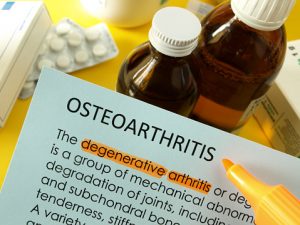 Osteoarthritis (degenerative arthritis) is a type of arthritis where the cartilage wears away, and it is usually associated with aging. There can be inflammation in osteoarthritis, but it is not a major characteristic of the condition, so a person who simply treats their osteoarthritis pain with anti-inflammatories may not experience much relief.
Osteoarthritis (degenerative arthritis) is a type of arthritis where the cartilage wears away, and it is usually associated with aging. There can be inflammation in osteoarthritis, but it is not a major characteristic of the condition, so a person who simply treats their osteoarthritis pain with anti-inflammatories may not experience much relief.
People who suffer from osteoarthritis experience the bones of their joints rubbing against each other, which causes friction and pain. In most cases, this rubbing affects the hands, knees, hip, and spine. Osteoarthritis is the most common type of arthritis that people suffer from.
Advertisement
The main characteristic of osteoarthritis, a degenerative disease, is the breakdown of cartilage—the cushion found between joints. Below you will find the causes, risk factors, symptoms, and treatment for osteoarthritis.
Causes and risk factors of osteoarthritis
Osteoarthritis is a wear-and-tear degenerative disease that can be caused by overuse, injury, obesity, heredity, or aging. Over time, the cartilage between the joints thins, causing the bones to rub together.
There are certain factors that will put you at a higher risk of getting osteoarthritis (OA). You do, though, have control over some of these factors.
Here’s a look at some features that can contribute to osteoarthritis.
Weight: People who have excess weight are putting added stress on their weight-bearing joints. The fat tissue produces proteins that can cause harmful inflammation around the joints.
Age: Nothing lasts forever, and as we age, our joints simply wear out.
Joint injuries: If you’ve experienced a sports injury, you can potentially expose your joints to the kind of stress that leads to OA.
Repetitive activity: Certain jobs or activities that put repeat stress on specific joints can cause joint deterioration.
Genetics: Some people just inherit a tendency to develop OA.
Deformities: Some people are born with defective cartilage or bone deformities that increase their risk of osteoarthritis.
Osteoarthritis symptoms
Unlike rheumatoid arthritis, where symptoms are worse in the morning and improve throughout the day, osteoarthritis symptoms worsen throughout the day. Osteoarthritis symptoms include joint stiffness, pain, and enlarged joints. Osteoarthritis symptoms often occur in larger joints, like the hip, but are also experienced in the knees and hands. Essentially, any joint that carries weight can experience the symptoms.
Osteoarthritis causes pain, stiffness, tenderness, reduction in mobility, a grating sensation when moving, and distortion or growth in the joints.
Degenerative arthritis diagnosis
A doctor will conduct a physical exam, paying close attention to the joints and checking for tenderness, redness, swelling, and range of motion—imaging and lab tests are also possible. X-rays can show cartilage loss and bone spurs. In complex cases, an MRI can also produce images of bone and soft tissue. As for the lab tests, analyzing blood and joint fluid can be helpful in confirming the diagnosis.
Treating osteoarthritis
Treatment for osteoarthritis should begin early on to prevent progression and complications. The objectives of osteoarthritis treatment include managing the symptoms, improving joint mobility and flexibility, maintaining a healthy weight, and getting adequate exercise. Physical activity has been shown to be quite beneficial to osteoarthritis patients, as it strengthens and builds muscles, easing the burden on the joints. Weight management is also important because excess weight adds unnecessary stress to already painful joints.
Other treatment methods include physical and occupational therapy to help patients find less painful methods to complete regular tasks, medications like anti-inflammatories and corticosteroids, use of assistive devices like a cane, and surgery if the joint is severely damaged and needs to be replaced.
OA treatments include some of the following:
Medications: Prescription and over-the-counter. More severe cases require stronger medications.
Lifestyle adjustments: Diet and exercise to alleviate pressure on joints.
Injections: Corticosteroids and hyaluronic acid to reduce inflammation and increase mobility.
Complementary therapies: Physical therapy, occupational therapy, canes, braces, and other assistance devices to help with changes in abilities.
Surgery: Badly damaged joints replaced with an artificial option to decrease pain and improve mobility.
Although many people reach for anti-inflammatory medications to treat osteoarthritis, numerous studies have found this to be ineffective. A study showed that Tylenol did perform slightly better than the placebo, but the researchers suggest that nonsteroidal anti-inflammatory drugs (NSAIDs) such as ibuprofen (Advil, Motrin) or diclofenac are better treatment options for osteoarthritis pain and function than Tylenol. While osteoarthritis is an inflammatory disease, acetaminophen products like Tylenol do not target inflammation. This explains why they are not effective for osteoarthritis.
Tai chi has been found to offer relief from OA as well—it was found to be particularly beneficial for patients who are overweight or obese, as they are more likely to develop knee osteoarthritis.
Dr. Chenchen Wang, Director of the Center for Complementary and Integrative Medicine, said, “Such people typically face limited options due to ineffectiveness of osteoarthritis treatments.”
Advertisement
At the end of the 12 weeks, participants answered questionnaires to evaluate pain, stiffness, and joint function. Both groups saw similar results, which lasted up to a year’s time.
Speak to your doctor about appropriate treatment methods in order to better live with osteoarthritis.
Related: Osteoarthritis knee pain relief at home: Easy tips and natural remedies
